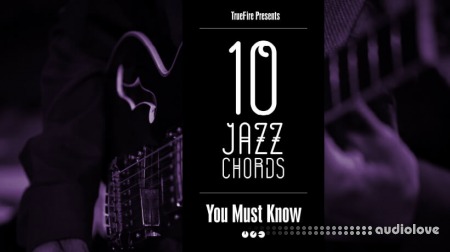Truefire Jeff Scheetz's 10 Jazz Guitar Chords You MUST Know

Learn How to Play Thousands of Hit Jazz Songs with These Must-Know Guitar Chords
Have you ever been daunted by the complex world of jazz? Worried that you'd have to memorize hundreds, if not thousands of chord shapes, progressions, and voicings to be able to play your favorite jazz standard? You're not alone. Lets dispel the myth that jazz guitar is an unreachable goal for many. In fact, with a mere 10 chord shapes, you can play virtually the entire jazz standard songbook!
Let's dive in and explore these 10 chords:
Root 6, Major 7th Chord
Root 6, Dominant 7th Chord
Root 6, minor 7th Chord
13th Chord
Root 5, 9th Chord
Root 5, Major 7th Chord
Root 5, Dominant 7th Chord
Root 5, minor 7th Chord
Root 5, minor 7b5 Chord
Diminished Chord
These chords are the foundation of jazz. They underpin the most common progressions found in jazz, such as the II-V-I, I-vi-II-V, and minor ii-V-I.
II-V-I Progression
Let's start with the ubiquitous II-V-I progression. It's a sequence of chords that you can find in almost every jazz standard, such as "Autumn Leaves" and "The Girl From Ipanema." Here, you would use your minor 7th (for the II chord), Dominant 7th (for the V chord), and Major 7th (for the I chord). For example, in the key of C, your progression would be Dm7-G7-CMaj7.
I-vi-II-V Progression
Next, we have the I-vi-II-V progression, often referred to as the "turnaround" progression. This progression is prevalent in songs like "I Got Rhythm" and "Blue Moon". For the I and II chords, you use the Major 7th and minor 7th respectively. The vi chord uses the minor 7b5, and the V chord uses the Dominant 7th or occasionally the 13th for a bit of spice. In the key of C, this progression would be CMaj7-Am7b5-Dm7-G7 (or G13).
Minor ii-V-i Progression
Lastly, there's the minor ii-V-i progression, a variation of the II-V-I but in a minor key. This progression is often found in songs like "Black Orpheus" and "Alone Together." Here, your ii chord would be a minor 7b5, your V would be a Dominant 7th or a 9th, and your i chord would be a minor 7th. In the key of C minor, your progression would be Dm7b5-G7(or G9)-Cm7.
These 10 chords and these common progressions form the backbone of most jazz standards. The beauty of jazz is in its expressive and improvisational nature, so even with these basic chords, you can experiment with various voicings and substitutions to add complexity to your playing.
Yes, jazz is complex, but it's not inaccessible. It's all about understanding the foundation and then building upon it, improvising, and making the music your own. And remember, you do NOT need hundreds of chords to play thousands of songs.
You'll have all of TrueFire's advanced learning tools at your finger tips to personalize your workspace and learn at your own pace.
You can loop, slow down, or speed up any section of a lesson. Plus, all of the tab and notation is synced to the videos for the optimal learning experience. You'll also get tab and standard notation files to print out, Guitar Pro files, and all of the backing tracks to practice with.
Grab your guitar and lets play some jazz!
Home page
DOWNLOAD
